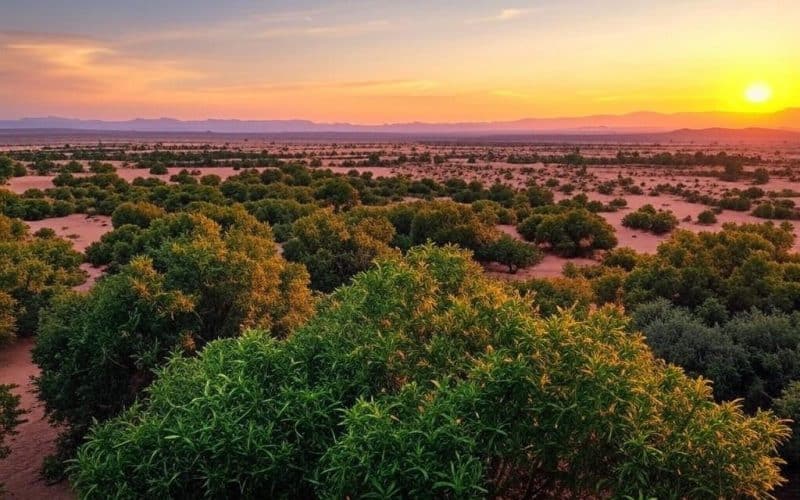
China has made remarkable efforts to combat desertification or desert expansion by planting vast numbers of trees. At least that is what is being said in all kinds of videos, news articles and comments posted online. However in reality the survival rate of trees in China’s desertification efforts has been a real problem.
Many of the trees planted struggle to adapt to the arid and nutrient-poor desert environment.
In this article we check the reality behind the facade of good news.
- 1 The Great Green Wall aka the Three-North Shelterbelt Program
- 2 Bridging the Gap Between Dreams and Reality to Halt Desert Expansion
- 3 Other Countries Perform Better than China When Halting Desert Expansion
- 3.1 1. Israel: Advanced Irrigation and Soil Management
- 3.2 2. Senegal and the African Great Green Wall:
- 3.3 3. Niger: Farmer-Managed Natural Regeneration (FMNR)
- 3.4 4. Ethiopia: Mass Mobilization for Reforestation
- 3.5 5. Australia: Regenerative Agriculture and Landcare
- 3.6 6. India: Afforestation and Green India Mission
- 4 So Why Did Things Go Wrong in China?
- 5 Tailored Approaches to Halt Desert Expansion
The Great Green Wall aka the Three-North Shelterbelt Program
The most prominent initiative which China promotes is the Great Green Wall, officially known as the Three-North Shelterbelt Program, which began in 1978. It aims to create a massive forest belt stretching over 4,500 kilometers across northern China to halt the encroachment of the Gobi Desert. To give you an idea, in 2000 the Gobi Desert expansion happened at a rate of 10,400 square km a year.
- Scale and Scope: By 2023, China had planted billions of trees across over 66 million hectares of land, making it one of the largest afforestation programs in the world.
- Technology and Methods: China uses drones to scatter seeds over barren land, combines traditional tree planting with advanced irrigation techniques, and employs scientific monitoring to improve survival rates.
- The aimed Benefits:
- Slowing Desertification: The program has reduced sandstorm frequencies, which were a major issue in cities like Beijing.
- Carbon Sequestration: Newly planted forests absorb large amounts of CO₂, helping mitigate climate change.
- Improved Livelihoods: Farmers and rural workers benefit from government incentives and jobs linked to afforestation.
Bridging the Gap Between Dreams and Reality to Halt Desert Expansion
China planting trees to prevent desert expansion
— Science girl (@gunsnrosesgirl3) December 29, 2024
pic.twitter.com/H22oeHBEHf
Despite the good news show the survival rate of trees in China’s efforts to halt desert expansion has been a critical issue. Many of the trees planted as part of the Great Green Wall and similar projects struggle to adapt to the arid and nutrient-poor desert environment. This issue stems from several factors which we explain below.
Reasons for Low Survival Rates:
- Monoculture Plantations: The large-scale planting of single tree species, such as poplars, has led to reduced biodiversity. This lack of diversity makes forests more susceptible to diseases and pests, as evidenced in 2000 when a disease devastated approximately one billion poplar trees in Ningxia, undermining two decades of afforestation efforts.
- Water Resource Depletion: Afforestation in arid and semi-arid regions has exacerbated water shortages. Fast-growing tree species consume substantial groundwater, depleting resources essential for local communities and ecosystems. Research on the Loess Plateau indicates that exotic tree species and high-density planting can worsen water scarcity.
- Low Survival Rates: The survival rate of planted trees has been low, with some estimates suggesting only a 15% success rate in arid regions. This inefficiency raises concerns about the sustainability and cost-effectiveness of large-scale planting initiatives.
- Soil Degradation: Inappropriate species selection and planting techniques have led to soil degradation. Certain tree species can alter soil composition, reducing its fertility and further hindering vegetation growth.
- Overemphasis on Tree Planting: Focusing predominantly on tree planting overlooks other vital aspects of ecosystem restoration, such as grassland rehabilitation and sustainable land management practices. This narrow approach may not address the root causes of desertification.
Measures to Address Low Survival Rates:
- Using Native Species: A shift toward planting native, drought-resistant vegetation improves adaptability and resilience.
- Mixed Planting Strategies: Diversifying species promotes ecosystem balance and reduces the risk of large-scale failures.
- Soil Restoration: Integrating soil improvement techniques, such as adding organic matter or using cover crops, enhances tree survival.
- Scientific Monitoring: Advanced monitoring systems identify areas where trees are failing and allow adjustments in strategy.
- Community Involvement: Engaging local communities ensures better maintenance and sustainable water use.
China will have to address these challenges and transition from focusing solely on planting numbers to creating sustainable and thriving ecosystems that effectively combat desert expansions.
Other Countries Perform Better than China When Halting Desert Expansion
Several countries have implemented innovative and effective approaches to combat desertification, often tailored to their unique environments and challenges, and thus giving better results than in China. Here are some examples:
1. Israel: Advanced Irrigation and Soil Management
- Israel uses cutting-edge drip irrigation and water recycling techniques to maximize agricultural productivity in arid regions.
- Techniques like contour plowing and mulching help retain soil moisture and prevent erosion.
2. Senegal and the African Great Green Wall:
- Senegal plays a leading role in Africa’s Great Green Wall project, which aims to restore degraded land across 11 countries.
- The initiative combines native tree planting with sustainable farming practices, such as agroforestry, that improve local livelihoods while restoring ecosystems.
3. Niger: Farmer-Managed Natural Regeneration (FMNR)
- Farmers in Niger have successfully revived millions of hectares of degraded land by encouraging the growth of native tree stumps and shrubs.
- FMNR is cost-effective and enhances soil fertility, boosting agricultural yields without extensive reforestation campaigns.
4. Ethiopia: Mass Mobilization for Reforestation
- Ethiopia has conducted massive tree-planting campaigns, including planting over 350 million trees in a single day in 2019.
- These efforts are paired with community-based watershed management (by using water bunds for instance), which restores water resources and combats erosion.
5. Australia: Regenerative Agriculture and Landcare
- Australia’s Landcare Program encourages communities to restore landscapes using regenerative agriculture techniques like no-till farming and reintroducing native plants.
- Projects focus on reducing salinity and improving biodiversity, addressing desertification at its root causes.
6. India: Afforestation and Green India Mission
- India’s Green India Mission promotes afforestation with a focus on ecological restoration and biodiversity conservation.
- Water conservation measures, like check dams and rainwater harvesting, work alongside reforestation to ensure sustainability.
So Why Did Things Go Wrong in China?
China’s challenges in combating desertification are influenced by several factors, including policy implementation, environmental conditions, and socio-economic considerations. While cultural aspects may play a role, attributing the difficulties solely to “Chinese mentality” oversimplifies the issue. Key factors include:
- Policy Implementation and Governance: China’s top-down approach emphasizes rapid, large-scale projects. This urgency has led to insufficient consideration of local ecological conditions, resulting in the selection of inappropriate tree species and planting methods. Additionally, local officials prioritized meeting national targets over sustainable practices, leading to the planting of monocultures that are more susceptible to disease and environmental stress.
- Environmental and Climatic Challenges: The regions targeted for afforestation are often arid or semi-arid, presenting inherent difficulties for tree survival. The selection of non-native species exacerbates these challenges, as they may require more water than is available, leading to low survival rates and further degradation of the land.
- Economic and Development Pressures: China’s rapid economic growth has sometimes led to environmental degradation, including deforestation and overgrazing, which contribute to desertification. Efforts to reverse these effects through afforestation are complicated by ongoing development needs and the demand for agricultural land.
- Public Participation and Awareness: While there have been significant tree-planting campaigns involving the public, the overall level of environmental awareness and participation in decision-making processes is limited. Greater public involvement and education could enhance the effectiveness and sustainability of anti-desertification efforts.
Tailored Approaches to Halt Desert Expansion
Successful efforts to combat desert expansions rely on tailored approaches that respect local conditions, active community involvement to ensure sustainability, and the integration of modern technology with traditional knowledge. Together, these strategies create impactful, long-lasting solutions to protect our land and livelihoods.
